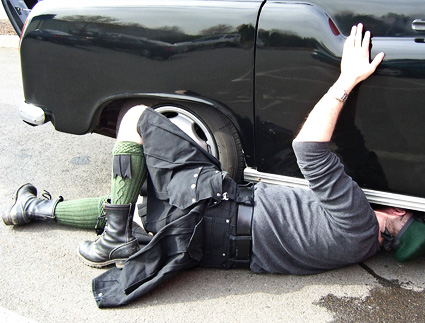

|
|
|
 |
Sharon Rose
This pair of kilt hose was designed for my then-husband, who was never quite satisfied with the tall socks available at the local Scottish shop. His clan, Rose of Kilravock (pronounced “Kill-rock”), has their ancestral castle near Inverness in Scotland. He grew up wearing the traditional tartan but has since discovered the oh-so-practical Utilikilt. I knit these as a means of encouraging him to wear the kilt as frequently as possible. It was those legs, after all, that caught my eye the first time I saw him. |
|
Kilravock starts with a heavily cabled
cuff that folds over to hide garters, although
they will stay up on their own. A ribbed leg
ensures a perfect fit to show off the lad’s calves, and
a simple cable adds interest down the side of the leg. When worn,
change in the leg diameter creates a shift in the cable: It’s
rounder near the top and gradually elongates
as it approaches the ankle. Knit from the top down with DPNs
or circulars, Kilravock is easily adjusted
for different sizes. |
|
|
|
|
|
|
|
FINISHED MEASUREMENTS |
|
MATERIALS
Notions |
|
PATTERN NOTES |
|
Pattern as written will accommodate calves 10-16.5 inches in circumference. If your intended leg is slimmer or wider, modify the stitch count in multiples of 4. The ribbing will automatically adjust from the calf muscle to the ankle, but additional shaping will be required for those with dramatic calf-to-ankle ratios. There are options for adapting the ankle to different instep heights in the Gusset Decrease section. C4F: Slip 2 sts to cable needle and hold to front of work;
k2 then k2 from cable needle. Working these without
a cable needle (great
instructions can be found on Grumperina’s
blog) will speed up the process considerably
for most knitters. Directions for grafting may be found here. Directions for a crochet chain border may be found here. Note: For perfect symmetry, on your second sock, replace the cable on Row 10 of the leg chart with a 4 stitch left cable. |
The charts for this pattern are very large and fit on a letter-sized page. Click here and print the resulting page. |
|
DIRECTIONS Graft the ends together as follows: With WS facing, pick up and knit 84 stitches evenly distributed around the other long side, starting at the join. The wrong side of the cable is now the right side of the work. (When the cuff is turned down, the right side of this cable will show on the outside.) Join for working in the round and note or mark beginning
of round with the unique marker. Next round: Work 34 sts in ribbing pattern; place new marker; work Row 1 of Leg Chart on 14 sts; place second new marker; continue rib pattern as established to end of round. Continue in pattern as established until leg measures 14 inches (or the actual measurement of the leg in question, from just under the knee to the ankle), ending after Row 15 of chart. Cable panel markers may be discarded now. HEELLeft Foot Heel Flap: Work partway across one more round, ending after stitch 48. Left heel row 1 [RS]: [Sl1, k1] 20 times, turn. Left heel row 2 [WS]: Sl 1, p39, turn. Repeat Left heel rows 1 & 2 until heel flap measures 2.5 inches long, ending after a Left heel row 2. Right Foot Heel Flap: Work one more full round (Chart round 16), and then continue partway across a second round, stopping after stitch 34. Turn so that WS is facing. Right heel row 1 [WS]: Sl 1, p39, turn. Right heel row 2 [RS]: [Sl1, k1] 20 times, turn. Repeat Right heel rows
1 & 2 until heel flap
measures 2.5 inches long, ending after
a Right heel
row 1. 67 sts total - 23 on the heel, and 44 instep stitches. GUSSET Gusset decrease: Work even in pattern as established until foot of sock measures 2 inches less than full foot length from back of heel. TOE Instep decrease round 1: Knit to first marker; ssk, work in pattern to 2 sts before second marker, k2tog; knit to end of round. 2 sts decreased. Repeat Instep decrease round 1 once more. 40 sts between the markers on the instep. Toe decrease round 1: K to 2 sts before first marker, k2tog; slip marker, ssk, knit to 2 sts before second marker, k2tog, slip marker, ssk; knit to end. Toe decrease round 2: Knit. Repeat the last two rounds until 20 stitches remain. Graft toe closed. |
|
FINISHING |
| ABOUT THE DESIGNER |
|
Sharon Rose knits, spins, and works other
types of needle-oriented
magic in Portland, OR. |
|
Pattern & images © 2010 Sharon Rose. Contact Sharon |